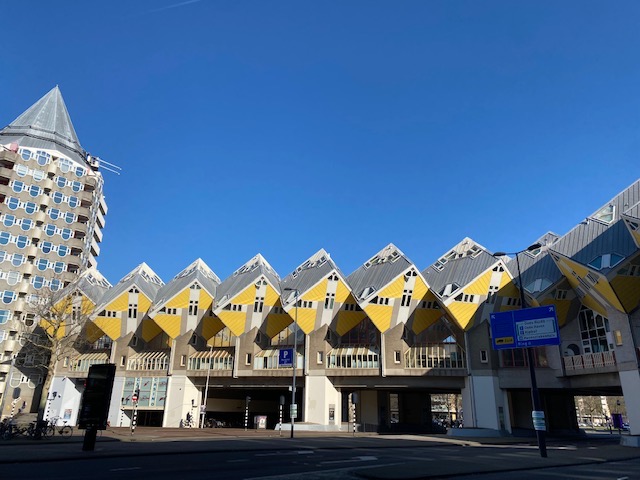words and images by Jess Margetson
Architecture changes with society’s artistic tastes, available materials, modern technologies, and spiritual beliefs. With a deep and varied cultural heritage, Europe is a goldmine for architecture enthusiasts. From modern inventions to historical memorials, Europe has something for all tastes.
Netherlands: Rotterdam vs Amsterdam
Described as the ÔÇÿGateway to EuropeÔÇÖ, Rotterdam has rivalled its capitol, Amsterdam, for many years. The differences in architecture between the two cities is stark.
Last year, I had the opportunity to visit a friend in Rotterdam. I found the city to be a spectacular representation of modern architecture with landmarks, such as the Cube Houses and the Erasmus bridge, piquing my interest and opening my eyes to the cityÔÇÖs rich history.
At the beginning of WWII, virtually the entire city was devastated by German bombs, which targeted its all-important port, resulting in a lack of historical, pre-war buildings. Once the war ended, reconstruction was the municipalityÔÇÖs top priority. This complete rebuild included new, cutting-edge architecture, a redesign of the city districts, and modern high-rise buildings.
Now, almost seventy years later, a new, modern city centre has risen from the ashes. The avant-garde architecture is increasingly gaining fame and popularity amongst travelers, once again becoming a dynamic city bustling with activity.
Amsterdam, however, enjoys a more traditional style of building including luxurious canal houses and charming gabled facades spreading across the 100km canals.
Although Amsterdam is a gorgeously picturesque capitol with lots to do and see, I found myself growing tired of the weed-blowing tourists filling up the streets and instead longed to return to the less chaotic, modern architecture that Rotterdam had to offer.
Walking around Rotterdam, you can sense thereÔÇÖs so much happening culture wise and that feels exciting!
So what does Rotterdam offer?
Erasmusburg ÔÇô unveiled in 1990s and named after the famous Rotterdam Renaissance humanist Desiderius Erasmus, the 802-metre long bascule bridge was built to connect the regenerated Kop van Zuid neighbourhood with the city centre. Interestingly, this design has been met with some controversy. Whilst observing the bridge from the side, you canÔÇÖt help but notice the bent pylon resembles a leg. Less sexist viewers however might recognize an elegant swan in the pylon which explains its nickname, the Swan. For the best views of the bridge, come at night when itÔÇÖs beautifully lit.
Cube Houses ÔÇô Imagine living in a bright yellow house that is merely 100-metres-squared! Now picture your house is tilted and secured on its corner. ItÔÇÖs difficult to imagine, isnÔÇÖt it? IÔÇÖm not sure if IÔÇÖd be rushing to move in, however, it is definitely must-see. Built in the 1980s by Piet Blom, the Cube Houses are certainly the quirky architectural gem of Rotterdam. Bonus: you can explore inside.

Markthal – Right next to the Cube Houses, youÔÇÖll find the massive food market named Markthal. This sustainable building in the shape of an upside-down horseshoe is filled with an array of foods and treats. Despite its lack of seating, IÔÇÖd highly recommend venturing through the stalls and trying a Stroopwaffel, one of Netherlands unique delicacies.
Keep an eye out for the impressive ceiling art ÔÇô ÔÇÿHorn of PlentyÔÇÖ by Arno Coenen and Iris Roskam. ItÔÇÖs undoubtedly the marketÔÇÖs most breathtaking feature.
Although this city may look incredibly modern, it is steeped in so much history, evident by the ÔÇÿDe BrandgrensÔÇÖ (The Blaze Boundary). To bring RotterdamÔÇÖs history to the forefront, the municipality decided in 2006 to mark the border of areas that were destroyed during the war with specially designed glowing red lamps in the ground.
Brussels, Belgium
Brussels, to me, is an architectural treasure map, which unfortunately I had limited time to explore. Much like Rotterdam, most of its original architecture was destroyed during the 1695 bombardment by French troops, resulting in a haphazardly eclectic postwar urban evolution.
At night, the city seems to buzz with people and music. Many tourists gather in the gloriously illuminated Grand Place with a view of the Town Hall and Guildhalls. The bilingual street names around the square still commemorate the outdoor markets that popped up along them around the 13th century. Additionally, the names of the guildhalls on the plaza are based on professions and goods. The rest are all restorations of Louis XIV from the 17th to 19th century that are an incredibly great mix of Gothic, Baroque, and other styles.
Again similarly to Rotterdam, so much of the countryÔÇÖs history is haunted by the horrors of the war. I visited several war memorials in the Belgian province of West Flanders, such as Boezinge, Langemark German War Cemetery, and the Tyne Cot Cemetery.
Meinin Gate – During my trip, I was lucky enough to witness an incredibly moving event take place. In the city of Ypres, I visited the Menin Gate, a vast, white stone archway that is in its simplest form a crossing point. That said, you canÔÇÖt overlook the special significance of this architecture. It was from this spot that thousands of soldiers set off for the part of the Front called the Ypres Salient ÔÇô many destined never to return. Since 1928, the Last Post has been played in this very spot every night at 8p.m. The white stone walls are engraved with the names of nearly 55,000 soldiers lost on the field of battle but with no known graves. This was an hauntingly overwhelming experience that I will never forget.
You simply cannot fault the staggeringly beautiful architecture and the rich history Europe is renowned for.




